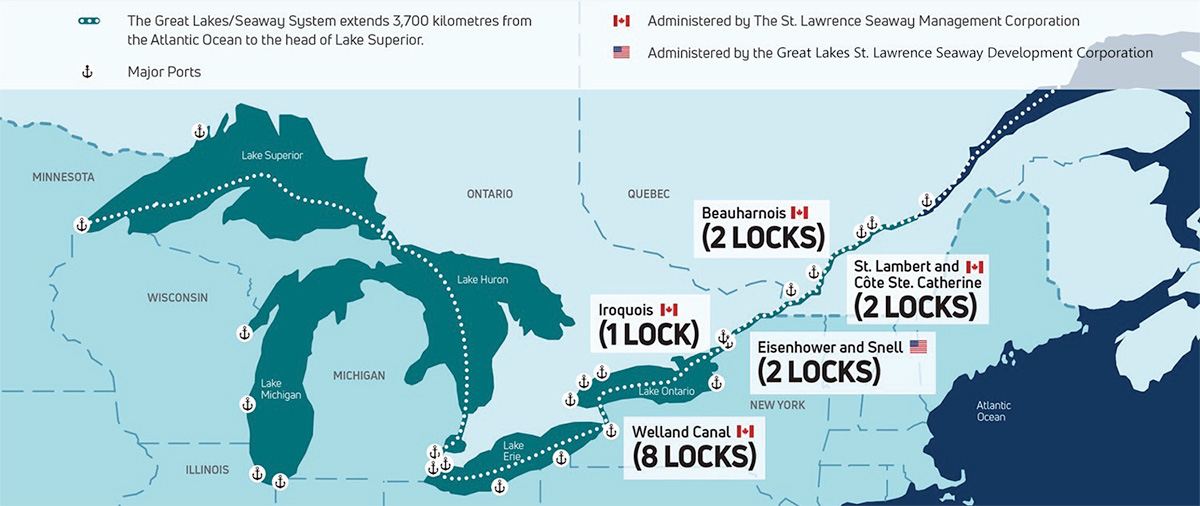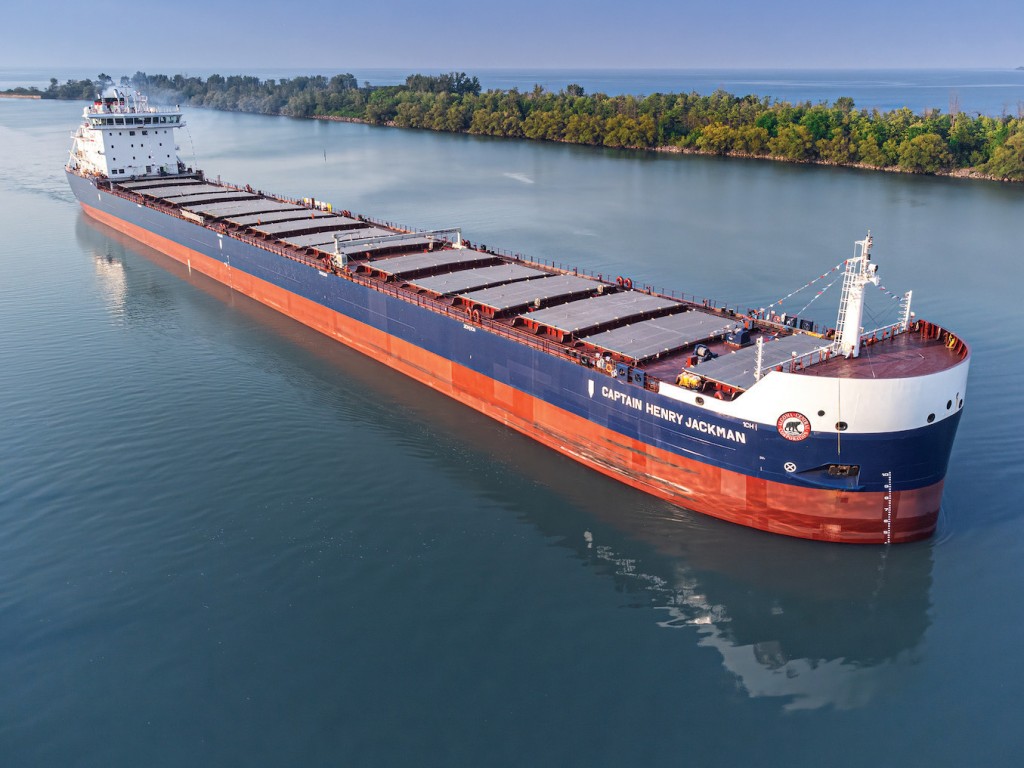The Seaway System is committed to reducing emissions and investing in infrastructure to provide more options for North American shippers.
The Great Lakes St. Lawrence Seaway System opened its 65th navigation season on March 23. The binational waterway is a key link in the North American supply chain, connecting ports on the United States and Canadian Great Lakes with ports the world over. Cargo movements on the Seaway total 35 million metric tons, support 237,000 jobs, and account for $35 billion in economic activity in the U.S. and Canada annually.
The Seaway is, first and foremost, a conduit for cargo. “With its advanced technology, the Seaway provides a reliable transportation route for ships transiting the system carrying a wide range of commodities,” said Terence Bowles, president and CEO of the St. Lawrence Seaway Management Corporation (SLSMC), the Canadian agency that helps administer the system. “A few examples are grains for breads and pasta, iron ore and coal for steel used in vehicles and appliances, and cement for bridges and roads.”

Supply Chain Resiliency
Cargo numbers for the Seaway’s 2022 navigation season, which stretched from March 22, 2022, to January 9, 2023, were mixed. (See box on next column)
The system also contributes to North American environmental stewardship and supply chain resiliency. “New technologies, an exceptional reliability record, and significant investments in infrastructure are enhancing efficiencies and keeping the Seaway safe and competitive,” said Adam Tindall-Schlicht, administrator of Great Lakes St. Lawrence Seaway Development Corporation (GLS), the U.S. counterpart to SLSMC.
On the environmental front, the SLSMC and GLS are part of a joint undertaking by the Canadian and U.S. governments to establish a green shipping corridor. “A prime example of our commitment to environmental goals can be seen through the SLSMC’s long track record in generating clean hydro-electric power,” said Bowles. “The Welland Canal operates on self-sufficient energy, resulting in a substantial reduction in our carbon footprint. Our decarbonization efforts include the gradual replacement of gasoline and diesel-powered equipment with electric alternatives.”
The Welland Canal portion of the SLSMC has been producing its own hydroelectric power since 1932. Hydroelectric power transmitted from the canal powerhouse supplies electricity for the equivalent of 5,000 homes per year. The powerhouse, located at the base of Lock 4 of the canal, features a 22,000-volt distribution system that runs from Lake Erie to Lake Ontario, houses two five megawatt hydroelectric generators, and produces a maximum of six megawatts at any given time. It supplies power to eight bridges, 11 locks, navigation lights, and several buildings and structures.

Green and Canada Net Zero Emissions
Canada’s Net-Zero Emissions Accountability Act, enacted in 2021, mandates greenhouse gas reduction goals of 40% to 45% below 2005 by 2030. “The SLSMC has already surpassed those targets,” said Bowles, “reaching 58% in 2022.” He attributed those reductions to increased energy efficiency in SLSMC buildings, replacement of fuel-powered equipment with electrical equipment, and increased fuel efficiency of corporate vehicles.
The Seaway’s reliability, which surpassed 99% in 2022, “helps reduce fuel consumption and lower emissions,” said Bowles. The Seaway also supports efforts to develop new technologies such as hands-free mooring, he added, which increases ship turn times and improves productivity. The technology also reduces energy consumption and emissions by over 90% during berthing thanks to the reduced use of tugs and ship engines.
As members of Green Marine, an environmental performance measurement program for the maritime industry, the SLSMC and GLS align their scores and provide results on an aggregated basis—which reached 4.7 out of a maximum of 5 in 2022.
The SLSMC is currently developing a voyage information system (VIS), a collaborative data sharing environment that will connect maritime stakeholders, and will “enable informed decision-making, optimized lock schedules, and improved resource coordination,” said Bowles. The VIS will create a virtual network for stakeholders to exchange vessel voyage and transit information and support decision-making processes. Use of the VIS will improve scheduling, planning, and coordination of resources to reduce greenhouse gas emissions, according to Bowles.
A long history of investments and reliability demonstrate that “the Great Lakes are uniquely positioned to weather upheavals in the global supply chain,” said Tindall-Schlicht. “The Seaway System is a leading example of a worldwide economically-resilient and environmentally-sustainable shipping corridor.”
Supply Chain Alternatives
One way the Seaway authorities work to enhance North American supply chain resiliency is to provide shippers with new supply chain alternatives through real estate investments and economic development. According to an SLSMC document, the agency “manages substantial land holdings and is always interested in exploring new business opportunities,” including those that contribute to system competitiveness, optimal utilization of real estate, diversification of cargoes, and regional economic development.
A notable project undertaken in 2022 was the wharf revitalization in Port Colborne, which aims to increase the area’s freight-handling capacity by over one million tons, presenting significant growth potential. In 2021, economic development projects included the shipyard and cement works developments, as well as the Saint Catharine commercial hub, all in Ontario.
In the 2022/2023 fiscal year, the SLSMC invested $73.7 million in infrastructure renewal and maintenance, with the goals of bolstering the supply chain and promoting long-term safety and economic growth. During the 2021-2022 fiscal year, the SLSMC spent $75.7 million on infrastructure.
Major projects executed in 2022/2023 year include a project at Lock 8 of the Welland Canal, where a gate replacement project was begun, and the replacement of a steel deck of an historic lift bridge over the canal.
In the Montreal/Lake Ontario section, counterweight cables on the St-Louis de Gonzague vertical lift bridge near Salaberry-de-Valleyfield, Quebec, were replaced. New and improved air bubblers and air curtains at the St.-Lambert lock were installed to enhance the management of ice during winter operating conditions.
During the last fiscal year, an investment by the SLSMC made bridge operations in the Beauharnois Canal more predictable and accurate to remedy ongoing issues over impacts of bridge operations and lifts on local commuters. Technology changes which were implemented make information on the bridge status more accurate, allowing for easier travel for motorists and recreational boaters. The SLSMC plans to use this technology in other areas of the Seaway.





